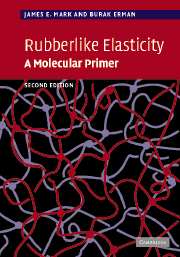Book contents
- Frontmatter
- Contents
- Preface to the first edition
- Preface to the second edition
- Part I Fundamentals
- 1 Introduction
- 2 Some rubberlike materials
- 3 The single molecule: theory and experiment
- 4 Preparation and structure of networks
- 5 Elementary statistical theory for idealized networks
- 6 Statistical theory for real networks
- 7 Elastic equations of state and force–deformation relations
- 8 Swelling of networks and volume phase transitions
- 9 Force as a function of temperature
- 10 Model elastomers
- Part II Additional topics
- Appendix A Relationships between ν, ξ and Mc
- Appendix B Relationships between 〈r2〉, 〈(Δr)2〉, 〈r2〉0, and ϕ
- Appendix C Equations of state for miscellaneous deformations from the constrained junction theory
- Appendix D Thermodynamics of the relationship of stress to temperature
- Problems
- Answers to problems
- Some publications describing laboratory/classroom experiments or demonstrations
- References
- Index
2 - Some rubberlike materials
from Part I - Fundamentals
Published online by Cambridge University Press: 04 December 2009
- Frontmatter
- Contents
- Preface to the first edition
- Preface to the second edition
- Part I Fundamentals
- 1 Introduction
- 2 Some rubberlike materials
- 3 The single molecule: theory and experiment
- 4 Preparation and structure of networks
- 5 Elementary statistical theory for idealized networks
- 6 Statistical theory for real networks
- 7 Elastic equations of state and force–deformation relations
- 8 Swelling of networks and volume phase transitions
- 9 Force as a function of temperature
- 10 Model elastomers
- Part II Additional topics
- Appendix A Relationships between ν, ξ and Mc
- Appendix B Relationships between 〈r2〉, 〈(Δr)2〉, 〈r2〉0, and ϕ
- Appendix C Equations of state for miscellaneous deformations from the constrained junction theory
- Appendix D Thermodynamics of the relationship of stress to temperature
- Problems
- Answers to problems
- Some publications describing laboratory/classroom experiments or demonstrations
- References
- Index
Summary
Polymers that are normally rubberlike (unswollen at ambient temperatures)
As mentioned in Chapter 1, the preparation of an elastomeric material requires that the polymer chains being cross linked be relatively long and have significant flexibility and mobility. Examples of polymers meeting these requirements (Morton, 1987; Treloar, 1975; Mark, 2003a, 2004b; Mark et al., 2005b, c) are given in Table 2.1, along with their structures and transition temperatures (Brandrup et al., 1999; Mark, 2005b; Mark et al., 2005b, c). As can be seen from the structures given, these typical chains have no rings as part of the backbone repeat unit, and very few bulky side groups. This is to be expected, since such structural features would give an undesirable decrease in the flexibility of the polymer (Mark et al., 2004). The high flexibility of these chains is demonstrated in part by the relatively low values they exhibit for the glass transition temperature Tg, which is the temperature below which flexibility is so reduced that the material becomes glassy (Ngai, 2004).
Natural rubber, which is essentially 100% of the cis-1,4 form of polyisoprene, has a relatively low value of Tg. Specifically, non-crystalline regions of this polymer will not lose their rubberlike elasticity until the temperature falls below −73 °C. Significant amounts of crystallinity in the undeformed state interfere with elastomeric behavior since the chain segments packed into crystallites obviously have their flexibility suppressed.
- Type
- Chapter
- Information
- Rubberlike ElasticityA Molecular Primer, pp. 19 - 24Publisher: Cambridge University PressPrint publication year: 2007



